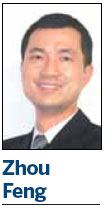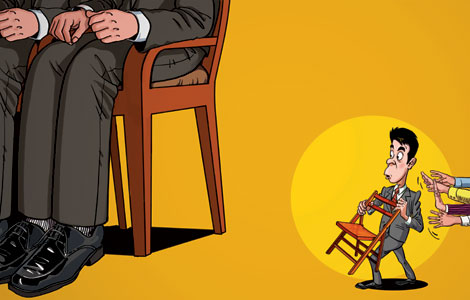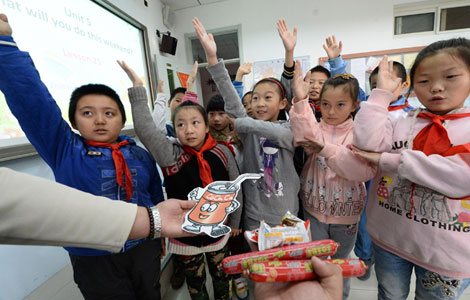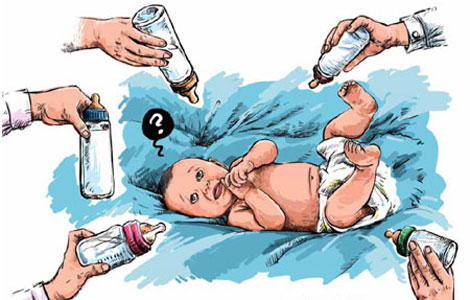Big turnaround or a dead-cat bounce?
Updated: 2013-10-25 09:58
By Zhou Feng (China Daily Europe)
|
|||||||||||
Much more needs to be done to ensure restructuring is not compromised
Gross domestic product in China grew 7.8 percent from July to September, the second-best performance since last year. The growth lifted the economy to a safe zone from what top policymakers deemed as the bottom line of 7.5 percent in the second quarter.
It is now safe to say China will meet its yearly target of GDP growth of at least 7.5 percent. It is very likely that growth for the year will be around 7.6 percent, or even higher.
But it is too early to celebrate, as economic figures in the third quarter delivered mixed messages. We need to see another quarter or two before we can answer this question: is this economic rebound really solid and favorable?
There were two positive improvements in the third quarter.
The first is about manufacturing. A slew of indicators have shown that it is stabilizing. The official purchasing managers' index hit a 17-month high of 51.5 points last month, showing that factories were turning on more machines thanks to better liquidity and more orders placed by Chinese and overseas buyers.
Manufacturing was the best performer among the three major industries. It beat mining and facility industries in terms of added value. Last month, the growth of added value of the manufacturing sector was 11.1 percent. It was a continuation of the double-digit growth witnessed since the start of the third quarter. In the second quarter, growth was below 10 percent.
Considering that China still counts a lot on manufacturing to propel economic growth and ensure employment, a rebound of the sector is a good sign.
The other positive sign was about trade.

With global demand rebounding, trade growth slightly recovered in the third quarter. Exports climbed 4 percent and imports 8.4 percent - better than the second quarter's 3.7 percent and 5 percent, respectively.
Considering that the figures in the second quarter were artificially exaggerated because of speculative capital flows in the disguise of foreign trade, especially in April, growth in the third quarter was remarkable. The speculative activities were checked only after authorities cracked down on fake trade and hot money flows slowed since May.
But not everything was cheerful.
China is still addicted to investment and the property market as a means to fuel the economy, a habit that is not helpful to China's economic restructuring.
After economic growth hit a multiyear low of 7.5 percent in the second quarter, the authorities took some pro-growth measures, including accelerating infrastructure investment such as in railways, sustaining spending in public housing and supporting first-time homebuyers.
So fixed-asset investment grew more quickly. In the third quarter, it jumped 20.3 percent, compared with 19.7 percent in the previous one.
The property market remained important in attracting investment. This trend became all the more obvious last month, with land deals rising 52.9 percent in terms of area and 102.5 percent in terms of value.
Property prices rose 20 percent in first-tier cities such as Beijing, Shanghai and Guangzhou in the third quarter, nearly double the growth in the second quarter.
In the July-September period, the central government refrained from taking new tightening measures, increased loan quotas for commercial banks and turned a blind eye to local governments' support for the property market.
All these helped boost the property market, which turned so hot that banks were running out of loans for property buyers by the end of September, which prompted the central bank to say the authorities would not intentionally curb loans for homebuyers.
The continued inaction from the central government may prompt several first-tier cities to put up more land lots for sale in the fourth quarter.
This also shows that Chinese policymakers still regard the property market as a panacea to deal with the slowdown.
But given that an overly booming property market distorts resource distribution, triggers asset bubbles and adds to speculation, this thinking does not help restructure the economy.
What can really advance the structural transition is social consumption. But this sector did not improve a lot in the third quarter.
The retail sales of consumer goods grew 13.3 percent in the third quarter, slightly better than the 13 percent in the second. The performance can be called stable rather than robust.
In the first three quarters, consumption's contribution to economic growth stood at 3.5 percentage points, much lower than 4.3 percentage points in the first quarter. Meanwhile, investment accounted for 4.3 percentage points in the first three quarters, compared with 2.3 percentage points in the first quarter.
Clearly, domestic consumption has given way to investment since the government launched pro-growth measures in the third quarter. This means economic restructuring was not heading in the direction that top policymakers had wished.
Of course, it is too soon to say the economic structure is deteriorating. After all, transforming the Chinese economy from one led by exports and investment to one driven mostly by consumption remains a long-term task.
Most likely, authorities are resorting to temporary pro-growth measures to quickly boost economic growth to a level that ensures enough employment. They are hoping stable growth will ensure more reform in sectors such as social welfare and finance.
The author is a Shanghai-based financial analyst. The views do not necessarily reflect those of China Daily.
(China Daily European Weekly 10/25/2013 page10)
Today's Top News
Mythbuster dispels fictions about China
Forum urges stableChina-Japan ties
NSA spying hurts US diplomacy
Carrier rocket sent to launch base for moon landing
Requirements cut for business startups
Study shows PM1 most harmful
Cold snap to sweep NE, N China
Paper apologizes for reporter's untrue stories
Hot Topics
Lunar probe , China growth forecasts, Emission rules get tougher, China seen through 'colored lens', International board,
Editor's Picks

|

|

|

|

|

|





